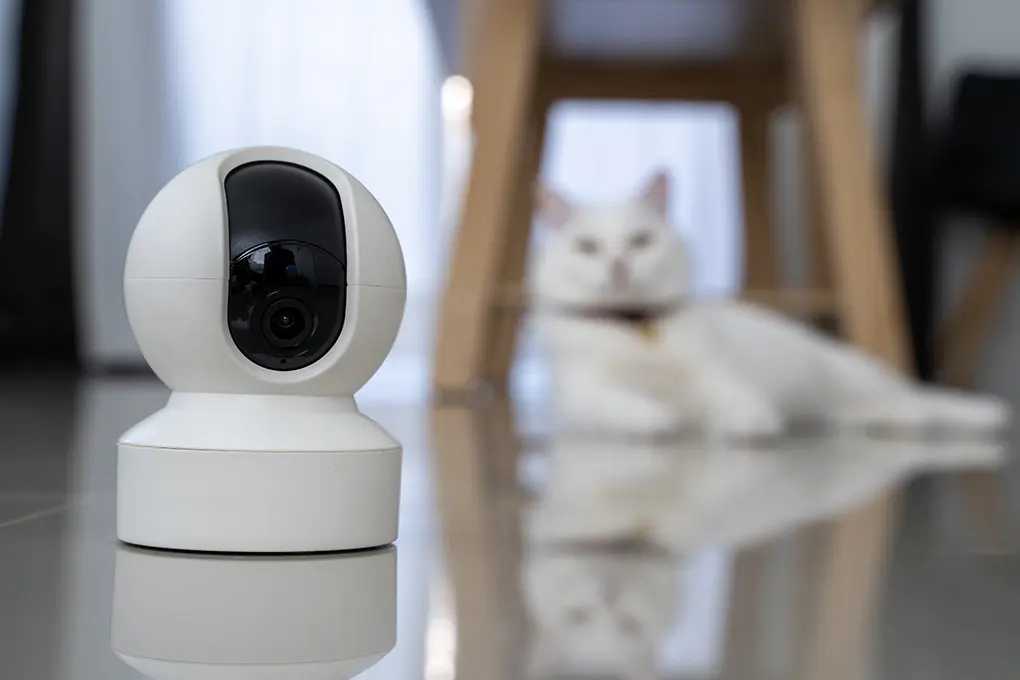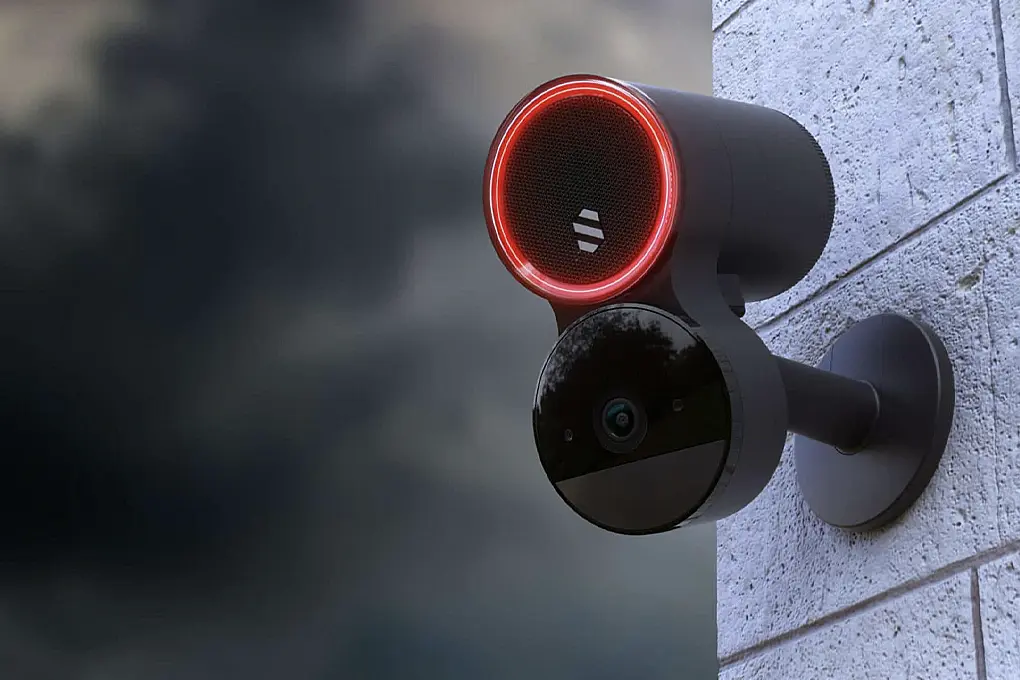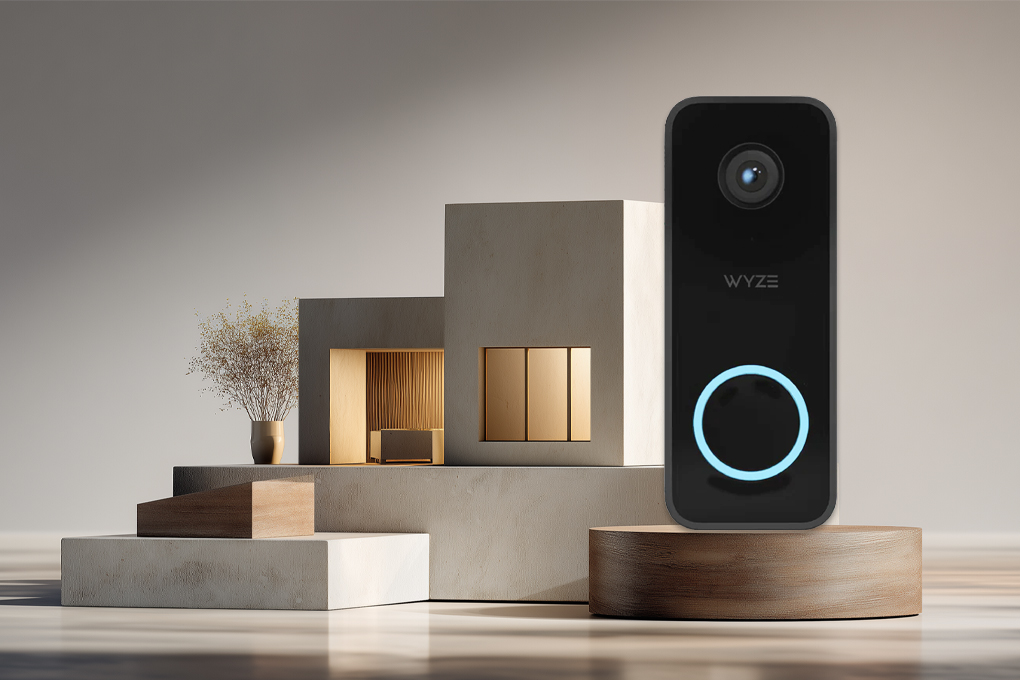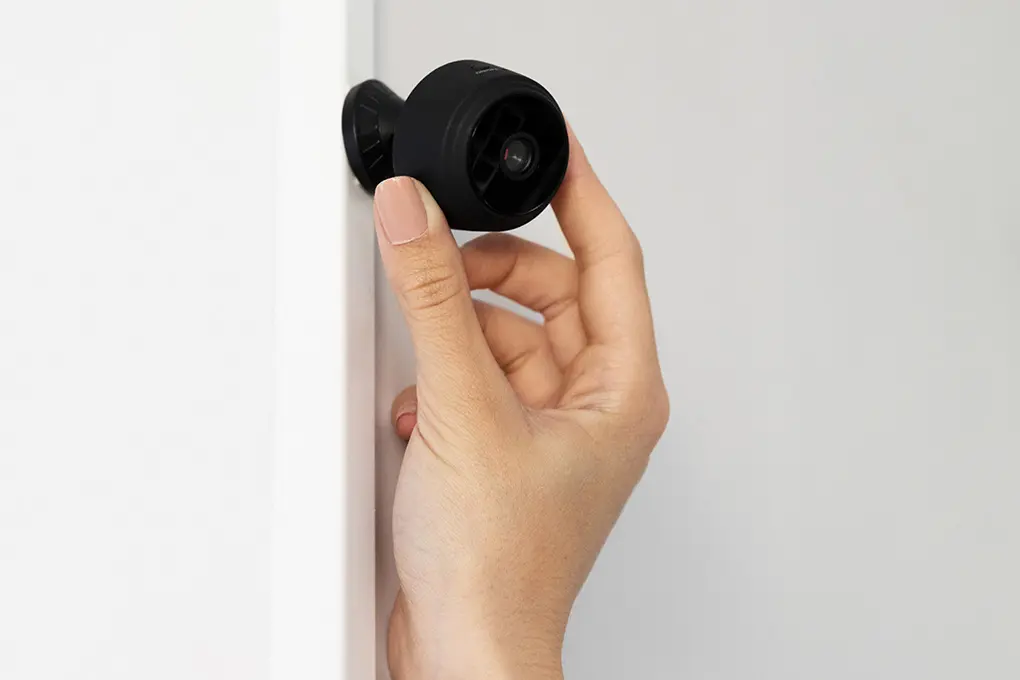Quick Answer: Light bulb security cameras screw directly into existing light sockets, combining LED lighting with video monitoring. They’re quick to install, renter-friendly, and affordable, making them ideal for entryways and porches. Compared to standard security cameras, they offer less weather protection, fewer placement options, and lower image quality in demanding conditions.
You screw a camera into a light socket and instantly have surveillance without drilling, wiring, or complicated installs.
That simplicity is what makes light bulb security cameras so appealing, especially for renters and first-time buyers. In this light bulb security camera review, the focus is on whether these socket-powered devices actually deliver on the promise of effortless protection.
The convenience is obvious – just replace a porch light or indoor bulb and gain coverage in seconds. But the real decision comes down to the light bulb cam vs standard cam question. Can a light bulb camera match the reliability, image quality, and features of a traditional security setup, or is it best seen as a budget-friendly alternative with trade-offs?
This guide explores where these cameras shine, where they fall short, and how to know if one fits your security needs.
Data Point: According to the FBI, in 2023, there were 839,563 home burglaries.

Table of Contents
- Key Takeaways
- An Introduction to Light Bulb Security Cameras: More Than Just a Novelty
- Installation Simplicity
- Features Driving Adoption of Light Bulb Security Cameras
- Real-World Performance: Where They Shine and Where They Struggle
- Comparison Chart: Light Bulb Cameras vs Standard Security Cameras
- Critical Limitations You Need to Consider
- Power Dependency: The Double-Edged Sword
- Storage and Subscription Considerations
- Who Should Choose Light Bulb Cameras?
- Security Scenarios: When Light Bulb Cameras Save the Day (And When They Don’t)
- Making the Right Choice: Light Bulb vs Traditional Cameras
- Final Thoughts on Light Bulb Security Cameras
- Frequently Asked Questions
- Sources
Key Takeaways
- Light bulb security cameras combine lighting and surveillance, making them easy to install, renter-friendly, and cost-effective.
- Modern models offer 2K-4K video, motion detection with AI filtering, two-way audio, and mobile app integration for added convenience.
- These devices work best for covered porches, patios, and entryways, with proven success in preventing package theft and deterring intruders.
- Limitations include socket-only placement, weaker weather resistance, smaller sensors, and dependency on constant power.
- Subscriptions for cloud storage can quickly raise long-term costs, often making light bulb cameras comparable in price to standard options.
- Traditional cameras remain superior for durability, placement flexibility, and advanced features like AI zones and extended night vision.
- Upgrade your home security today by exploring Batten’s expert-tested solutions that match your living situation and budget.
An Introduction to Light Bulb Security Cameras: More Than Just a Novelty
Light bulb security cameras combine LED lighting and video surveillance in a single E26/E27 socket-compatible unit. Unlike traditional systems that require separate power sources and permanent mounting, these devices draw electricity directly from existing fixtures while providing both illumination and monitoring. Beyond convenience, most models now feature motion detection, two-way audio, night vision, and smartphone integration through dedicated apps.
This technology has matured rapidly since its early models appeared around 2019. Today’s devices commonly offer 2K or even 4K resolution, color night vision powered by built-in LEDs, and AI-driven person detection that reduces false alerts from pets, swaying trees, or passing cars. Brands like LaView, Symynelec, and GE have refined their designs, combining improved camera optics with practical lighting features that fit seamlessly into everyday home use.
What separates light bulb cameras from standard security options is not only their appearance but also their practicality. For renters or frequent movers, the cost and effort of a permanent camera installation rarely make sense. Light bulb cameras bridge the gap, offering a quick and affordable way to gain extra protection without long-term commitments.
Data Point: Visible cameras deter up to 53% of would-be burglars.
Installation Simplicity
The biggest advantage of light bulb security cameras is their effortless installation. Where a traditional camera may take an hour to mount, drill, wire, and configure, a socket-powered unit can be set up in under five minutes. The process is straightforward: unscrew the existing bulb, screw in the camera, and complete the setup through the companion app.
Simple Connectivity
Most models use a QR code scan to connect to a 2.4GHz Wi-Fi network, which removes the technical hurdles that frustrate many first-time users. With power supplied directly through the light socket, there are no batteries to charge, no solar panels to position, and no exposed charging ports to maintain.
Perfect for Renters
For renters, the reversibility is invaluable. At move-out, the camera can be unscrewed and replaced with the original bulb, leaving no holes to patch or adhesive residue to clean. The ability to relocate the device instantly also appeals to anyone in temporary housing or strict lease agreements.
Features Driving Adoption of Light Bulb Security Cameras
Modern light bulb cameras are no longer barebones devices. They now include features that rival mid-tier traditional systems.

- High-Definition Video: Most devices offer 2K or 4K resolution, ensuring clarity for identifying details like faces or license plates.
- Color Night Vision: Built-in LEDs provide lighting that enables color recording even in low-light conditions.
- Motion Detection With AI Filtering: Smart technology distinguishes people or vehicles from background movement, reducing false notifications.
- Two-Way Audio: Integrated microphones and speakers allow real-time communication with visitors or delivery drivers.
- Mobile App Integration: Dedicated apps send notifications, enable live streaming, and store video, giving homeowners instant access wherever they are.
Real-World Performance: Where They Shine and Where They Struggle
Testing across different residential settings shows that light bulb cameras perform impressively in certain areas while revealing limitations in others. Their unique form factor brings both advantages and challenges depending on placement and environment.
Strong Coverage in Entryways and Patios
The LaView light bulb camera, for example, proved highly effective at monitoring front doors and small patios. Its 355-degree pan and 90-degree tilt provided near-complete coverage from a central ceiling fixture.
This overhead vantage point offered a clear view of faces, even when visitors wore hats or hoods, which often obstruct side-mounted camera angles. The built-in lighting further improved image clarity, particularly in low-light conditions.
Motion Detection Accuracy and AI Filtering
Motion detection accuracy varied across models and environments. Units mounted in covered porch fixtures performed well, with AI-powered person detection cutting false alerts by about 70% compared to basic motion detection.
This improvement was most noticeable in busy neighborhoods where passing cars or pets might otherwise trigger constant notifications. On the other hand, exposed outdoor sockets created problems during windy or rainy conditions, as weather movement repeatedly activated recordings despite advanced algorithms.
Dual Purpose: Lighting and Security
One of the standout advantages of these devices is their dual function as both security cameras and light sources. Through the companion app, users can remotely control the built-in LED, effectively adding an element of home automation.
This proved useful in two ways: first, as a deterrent when suspicious activity was noticed, and second, as a convenience feature for homeowners arriving late at night who could turn on the light before reaching the door.
Best Fit for Predictable Household Routines
These systems often work best in households with consistent schedules. Automating both lighting and recording times reduces false alerts, saves storage space, and ensures the camera’s features are used efficiently. Families who leave and return home at predictable hours find that these automations provide both security and everyday convenience.
Comparison Chart: Light Bulb Cameras vs Standard Security Cameras
| Feature | Light Bulb Cameras | Standard Security Cameras |
| Installation Time | 5-10 minutes | 30-90 minutes |
| Power Source | Light socket (always powered) | Battery, solar, or hardwired |
| Average Resolution | 1080p-2K (some 4K models) | 1080p-4K |
| Field of View | 355° pan, 90° tilt (motorized) | 110°-180° (fixed) |
| Weather Resistance | Limited (IP44-IP65) | Full (IP65-IP67) |
| Night Vision Range | 20-30 feet | 30-100 feet |
| Storage Options | Cloud or SD card | Cloud, SD card, or NVR |
| Average Price | $25-$60 | $30-$200 |
| Renter-Friendly | Yes (100% reversible) | Limited (adhesive/clamp mounts) |
| Professional Features | Basic | Advanced (zones, analytics) |
Critical Limitations You Need to Consider
Light bulb security cameras may offer unmatched convenience, but they also come with real design constraints that affect performance. Understanding these limitations helps determine if they are the right fit for your security needs.

Socket Placement Restrictions
The biggest limitation is mounting flexibility. These devices only work where light sockets already exist, which rules out many ideal surveillance positions such as fence posts, garage corners, or detached sheds. Traditional cameras can be mounted almost anywhere with power access, but a light bulb camera is confined to ceiling fixtures or outdoor sconces.
Weather Resistance Challenges
Weather protection is another weak point. While dedicated outdoor cameras often meet IP66 or IP67 ratings, most light bulb cameras max out at IP65, and many budget models sit at IP44.
These ratings mean they can handle light rain but may not withstand driving storms, snow, or extreme heat. Their upward-facing position can also allow water to collect near the lens, which risks blurred footage or long-term damage. For households in regions with heavy rain or high humidity, this is a serious concern.
Component Compromises in a Small Housing
Packing a camera, LED lighting array, Wi-Fi antenna, pan/tilt motor, and cooling system into a light bulb form factor requires trade-offs. Sensors are often smaller than those in standard cameras, which reduces low-light clarity even with built-in LEDs.
Two-way audio also suffers due to compact microphones and speakers that can sound distorted or tinny. For casual use these limitations may be acceptable, but for detailed evidence gathering, they fall short of dedicated models.
Power Dependency: The Double-Edged Sword
Power supply creates both benefits and drawbacks for light bulb cameras. Unlike battery-powered options, they never need recharging. However, this constant connection comes with caveats.
Switch Position Habits
Because these devices rely on uninterrupted power, the wall switch must remain in the “on” position at all times. Family members accustomed to flipping the switch on and off may accidentally disable the camera without realizing it.
Some households use switch guards or install smart switches to maintain power while still controlling the light through an app, but this adds cost and complexity to what should be a plug-and-play solution.
Vulnerability During Power Outages
Another concern is coverage during outages. Battery-powered cameras continue recording when the grid fails, while light bulb cameras shut down entirely. For homes in storm-prone regions or with unreliable electricity, this can create dangerous security gaps at the worst possible moments.
Data Point: Between 2021 and 2022, property crime rose by 7%.
Storage and Subscription Considerations
Storage options for light bulb cameras follow the same pattern as many consumer security devices, with local and cloud-based choices that vary in cost and convenience.

Local Storage Drawbacks
Most models support microSD cards, but accessing footage requires removing the entire camera from its socket. This makes reviewing video clips inconvenient and impractical for frequent use.
Cloud Subscriptions and Costs
Manufacturers typically encourage cloud subscriptions, which cost between $3 and $10 per month per camera. Free tiers often include only 24 hours of clips or basic motion alerts without playback, which is insufficient for most households. For rental properties or shared housing where recorded evidence might be critical, a subscription is almost unavoidable.
Long-Term Expense
While light bulb cameras may be affordable upfront – some starting as low as $30 – the subscription fees quickly erode that cost advantage.
A $30 device paired with a $5 monthly plan ends up costing $90 in the first year, making it comparable to mid-tier traditional cameras with better sensors and durability. For this reason, many users test a single camera and subscription before committing to a larger setup.
Who Should Choose Light Bulb Cameras?
Light bulb security cameras are not for everyone, but they shine in situations where ease of use, affordability, and quick installation matter most. Their strength lies in accessibility rather than advanced surveillance.
Ideal Candidates
These devices tend to work best for:
- Apartment renters with covered porches or patios
- Homeowners who want simple monitoring without drilling or cabling
- People living in temporary housing, such as vacation rentals or dorms
- Senior citizens who benefit from simple, low-maintenance setups
- Small business owners monitoring entry points or cash registers
- Anyone seeking an entry-level security solution under $100
Matching Expectations With Capabilities
The key is aligning expectations with what the technology can realistically deliver. These cameras are particularly effective for deterrence and general monitoring in protected areas with existing light fixtures.
They also work well for first-time users who might feel overwhelmed by the complexity of traditional systems. For budget-conscious buyers, reliable options under $100 provide a reasonable balance of convenience and functionality.
Security Scenarios: When Light Bulb Cameras Save the Day (And When They Don’t)
Practical examples highlight where these cameras perform strongly and where they fall short. Looking at user experiences and incident reports reveals clear patterns in real-world use.
Where Light Bulb Cameras Excel
One of the most effective uses is package theft prevention. Mounted in porch light fixtures, these cameras provide an overhead angle that captures delivery areas without obstruction. The built-in light not only improves visibility but also records details like package labels and delivery personnel faces.
In Phoenix, one homeowner’s camera captured both the face and license plate of a thief mid-act, leading to an arrest and recovery of over $800 in stolen items. The camera’s motion-activated light startled the suspect, ensuring a clear shot of identifying details that a side-mounted unit might have missed.
Proven Success Scenarios
- Visitor Screening for Apartments: Two-way audio allows residents to communicate safely, especially valuable for seniors confirming caregivers or service workers.
- Entry Point Monitoring: Overhead placement provides angles that avoid blind spots common with peepholes or side cameras.
- Active Deterrence: The combination of remote light control and audio warnings discourages opportunistic intruders before crimes escalate.
- Discrete Business Monitoring: Restaurant and retail owners use them to oversee cash handling or closing procedures without the appearance of obvious surveillance.
- Insurance Documentation: Overhead views of slip-and-fall accidents or delivery damage provide strong evidence for claims.
The integration of lighting with surveillance adds another layer of deterrence. A Chicago resident once stopped a garage break-in by activating their alley light and using the camera’s speaker to warn the intruder, who immediately fled. This quick response capability can be more effective than passive recording alone.
Where Light Bulb Cameras Fall Short
Weather remains one of the most significant challenges. During Hurricane Ian in 2022, multiple reports confirmed that light bulb cameras failed within hours despite being placed in recessed fixtures.
Driving rain and debris overwhelmed their limited weather protection, while traditional IP66-rated systems in the same neighborhoods continued functioning and provided critical footage for insurance claims.
Common Failure Points
- Perimeter Coverage: Light bulb sockets rarely exist where full property coverage is required, leaving blind spots.
- Investigative Limitations: Lower-resolution sensors produce footage too grainy for license plate capture or definitive identification.
- Weather Vulnerability: Heavy rain, snow, and extreme temperatures often disrupt or disable these devices.
- False Alerts: In exposed sockets, spiders, shadows, and blowing leaves frequently trigger hundreds of notifications.
- Night Coverage Gaps: Infrared and LED illumination often fail to capture clear footage beyond 20-30 feet.
A recent case in Seattle highlighted these shortcomings. A front door light bulb camera failed to record an intruder entering through a side window just 15 feet away.
Police later noted that while footage confirmed someone was present, the lack of detail made it useless for prosecution. False alerts represent another frequent frustration.
One homeowner reported receiving over 400 notifications in a single windy night due to branches and insects, eventually disabling alerts entirely. By contrast, traditional cameras with customizable zones and advanced AI filtering offer far better alert management without overwhelming users.
Making the Right Choice: Light Bulb vs Traditional Cameras
Choosing between a light bulb camera and a traditional security camera depends on your living situation, long-term plans, and the level of security you need. Light bulb cameras stand out for their convenience and portability, while traditional cameras excel when image quality, durability, and advanced features are priorities.
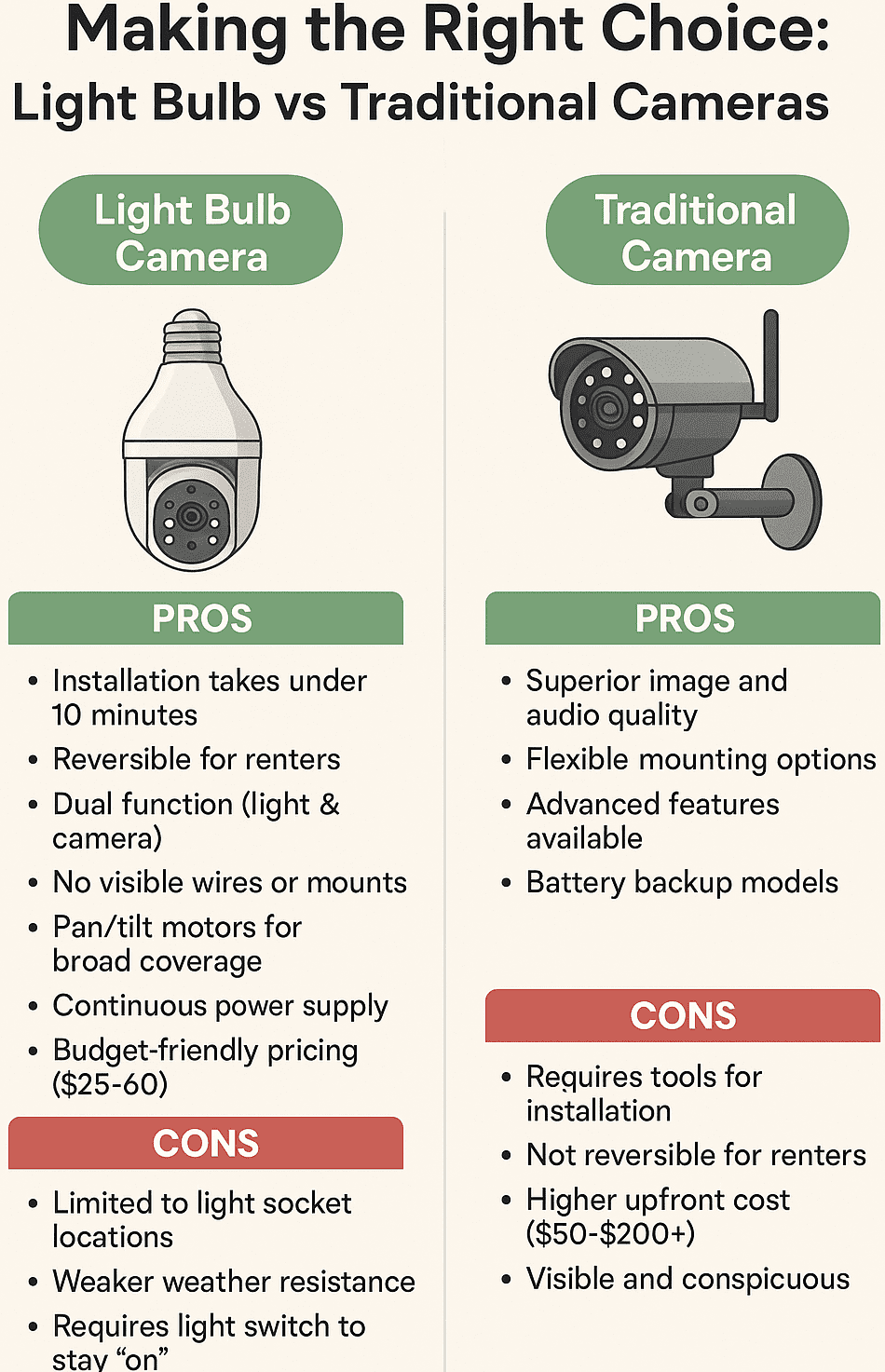
Light Bulb Camera Pros and Cons
Light bulb cameras shine in scenarios where convenience and easy installation matter most. Their form factor makes them particularly appealing to renters and first-time users.
Pros
- Installation takes less than 10 minutes with no tools or technical expertise
- Completely reversible for renters, leaving no damage behind
- Dual function combines lighting and surveillance in one device
- No visible wires or mounts to alert potential intruders
- Pan/tilt motors provide broad coverage from one location
- Continuous power supply removes the need for battery charging
- Entry-level pricing between $25 and $60 makes them budget-friendly
Cons
- Limited to existing light socket locations, reducing placement options
- Weather resistance is weaker than IP66/IP67-rated outdoor cameras
- Requires the light switch to stay “on” at all times, which can confuse guests or family members
- Compact components often result in lower image and audio quality
- Cloud subscriptions are usually required for full functionality
- No backup recording during power outages
- Heat buildup in enclosed fixtures can shorten device lifespan
Light bulb cameras are best for quick, entry-level protection or for adding coverage to areas already equipped with suitable light sockets.
Traditional Security Camera Pros and Cons
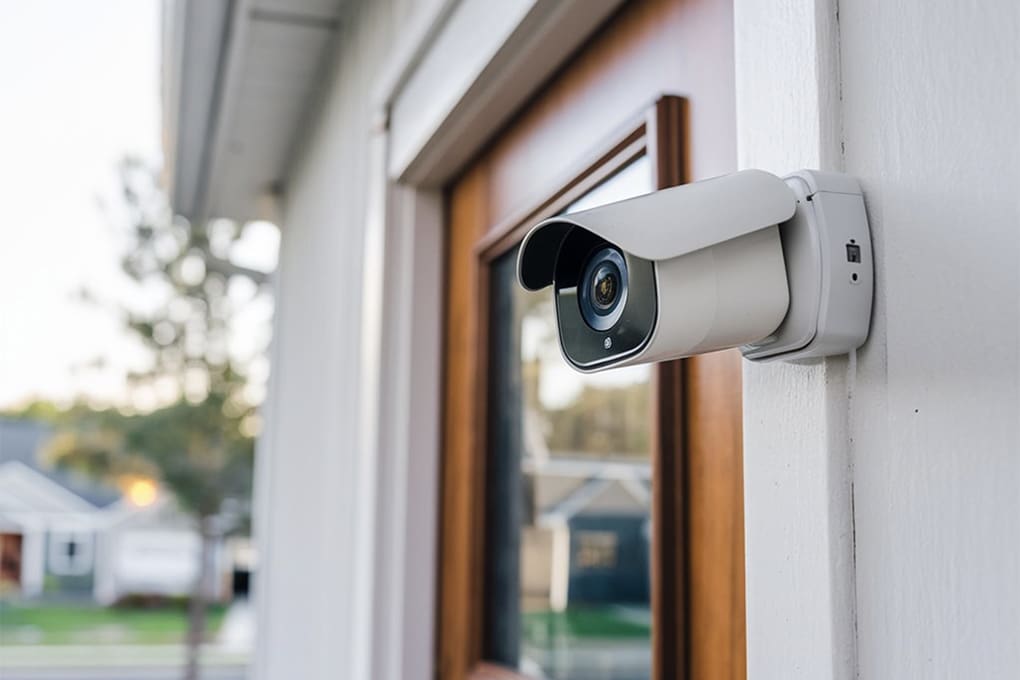
Traditional cameras are built for long-term setups and provide the advanced features and durability that light bulb cameras lack. For homeowners or businesses requiring robust coverage, they remain the preferred option.
Pros
- Can be mounted virtually anywhere for optimal coverage
- Larger sensors deliver superior image clarity and extended night vision
- Professional-grade weatherproofing (IP66/IP67) handles heavy storms, snow, and heat
- Advanced features such as AI-powered person/vehicle detection, custom motion zones, and local storage options
- Battery backup models maintain coverage during power outages
- Better two-way audio due to larger, dedicated microphones and speakers
- Compatible with professional monitoring services for higher levels of security
Cons
- Installation typically requires 30-90 minutes with tools and some technical know-how
- Drilling and wiring may damage walls, which is problematic for renters
- Higher upfront cost, often $50-200 per camera for reliable models
- Visible mounting hardware makes cameras obvious to intruders or visitors
- Battery-powered models need regular charging or solar setups
- Complex multi-camera systems may require professional installation
- Permanent placement makes relocation difficult once installed
Traditional cameras are best suited for homeowners who plan to stay long-term, need perimeter coverage, or want high-quality footage suitable for police investigations.
A Hybrid Approach for Comprehensive Security
For many households, a mix of light bulb and traditional cameras provides the most balanced solution. Light bulb cameras can secure entrances, porches, or garages where sockets already exist, offering quick deterrence with minimal effort.
Traditional cameras can then be used for critical areas such as property perimeters, blind spots, or locations without light fixtures.
This blended strategy delivers the convenience of socket-powered cameras alongside the reliability of professionally designed systems, ensuring that both renters and homeowners can optimize their security without overcommitting to one approach.
Special Considerations for Renters
For renters, light bulb cameras often make the most sense despite their limitations. The ability to install and remove them without damaging property protects security deposits and allows renters to take their equipment along when moving.
While traditional cameras offer better long-term performance, leaving behind a wired system is rarely practical for temporary living situations.
Final Thoughts on Light Bulb Security Cameras
Light bulb security cameras prove that home protection can be as simple as screwing in a bulb. Their quick installation, reversibility, and integration of lighting with surveillance make them a practical option for renters, first-time buyers, and budget-conscious households.
They shine in entryways, patios, and predictable routines, offering deterrence and basic coverage without drilling or wiring.
Yet, limitations such as restricted placement, weather resistance, and ongoing subscription costs highlight why they cannot fully replace traditional systems. For long-term homeowners or businesses, standard cameras deliver better durability, image quality, and advanced features.
In many cases, a hybrid approach strikes the right balance: socket-powered cameras for convenience and traditional models for comprehensive coverage. By matching expectations to capabilities, households can achieve effective, affordable security tailored to their unique needs.
Ready to upgrade your home security without the installation hassle? Browse Batten Home Security’s expert-tested cameras and smart security solutions. From simple light bulb cameras to comprehensive systems, find the perfect fit for your safety needs and living situation.
Frequently Asked Questions
Do Light Bulb Security Cameras Work With Dimmer Switches?
No, most light bulb cameras require constant, full power and will malfunction or even become damaged if used with dimmer switches. You’ll need to replace any dimmer with a standard on/off switch.
Can Light Bulb Cameras Record Without WiFi?
Yes, models with microSD card slots can record locally without an internet connection. However, you’ll lose remote viewing, alerts, and cloud storage features without WiFi.
How Much Electricity Do Light Bulb Cameras Use?
Most consume between 5 and 15 watts continuously, similar to leaving a standard LED bulb on all day. This typically adds about $5 to $10 to your annual electricity bill per camera.
Will Light Bulb Cameras Work in Enclosed Fixtures?
Heat buildup in enclosed fixtures can damage cameras and void warranties. For best performance and longevity, use them only in open or semi-enclosed fixtures with proper ventilation.
Do Light Bulb Cameras Work With Smart Home Systems?
Some models integrate with platforms like Alexa, Google Home, or Apple HomeKit, but compatibility varies by brand. Always confirm supported systems before purchase if you plan to connect your camera to voice commands or broader automation.
How Is Footage Stored and Accessed?
Most light bulb cameras support either local storage with a microSD card or cloud storage through a subscription plan. Local storage avoids recurring fees but requires manual access, while cloud services allow remote playback and backups at an added monthly cost.
Can Light Bulb Cameras Be Used Outdoors?
Many light bulb cameras are designed for outdoor use but typically only offer IP44-IP65 protection. They can withstand light rain but may not hold up well in heavy storms or extreme climates. For exposed areas, a fully weatherproof traditional camera may be more reliable.
How Long Do Light Bulb Cameras Last?
Lifespan depends on usage and placement, but most units last two to three years under regular use. Heat exposure, constant recording, and poor ventilation can shorten their life, while using them in shaded, well-ventilated fixtures often extends durability.
